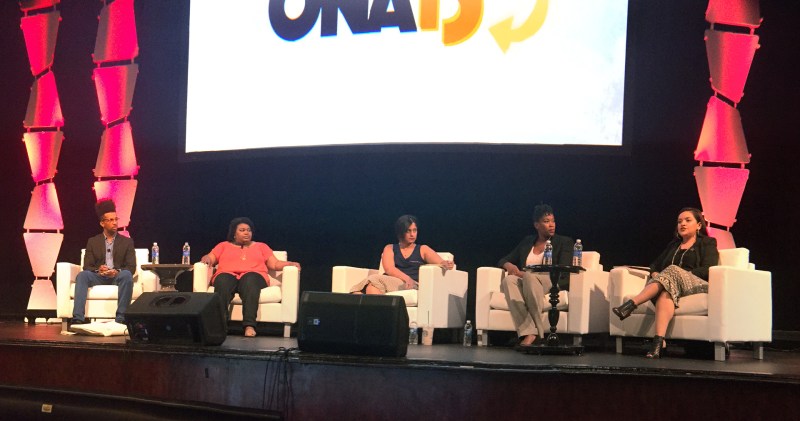By Kendall Trammell
ONA Newsroom
Tracie Powell never wanted to be the “black reporter.”
“Never my goal, never my agenda,” said Powell, the founder of All Digitocracy, speaking at an Online News Association panel on Thursday.
But her goal changed after she saw the mainstream media neglecting to cover stories from the black community. “After some time in the newsroom,” she said, “I felt like it was my responsibility to cover the communities and people who weren’t being covered.”
It’s a responsibility many journalists feel. They want to ensure the stories of their communities are told.

Tanzila Ahmed, co-host of The #GoodMuslimBadMuslim Podcast and another ONA15 panelist, pointed to the case of Ahmed Mohammed, who was arrested for bringing a clock to school that school officials said could have been a bomb, as an example.
She credited Anil Dash and other journalists and bloggers with bringing the story to the attention of mainstream media through social media. “These communities are making their own news,” she said. “If something is happening in that community, they’re doing it. They’re reporting it.”
Even those who are a part of the mainstream media admit there’s a problem.
“I would love to say we are perfect, but we’re not,” said David Plazas, the opinion engagement editor and editorial board chair for The Tennessean. “If we were, we wouldn’t have mixed competitors.”
He cited The Root and other niche sites as good examples, saying, “We have to do a better job of entering and going into these communities and building these relationships.”
These stories from underreported communities become more personal for the journalists who represent them. Personal narratives from reporters, like Wesley Lowery of The Washington Post and Gene Demby from NPR, became critical as they reported from the front lines of Ferguson, Missouri. As mainstream news paid closer attention to cases of police brutality across the country, several journalists shared a similar narrative.
When the police released the Sandra Bland dash cam video, Renee Graham thought back to when a police officer pulled her over. The blue lights from the cop car scared Graham, who was then 22 years old. She reached down to give the officer her license and registration. Before she could sit up straight, she saw his hand reaching for the gun in his holster.
“I almost burst into tears, I was so scared,” said Graham, a contributor at The Boston Globe. “You don’t just write about it. You’re living it.”
After the Supreme Court’s ruling on same-sex marriage, Plazas lived the story of a gay man whose marriage with his spouse Darren Bradford was recognized in all 50 states. He wrote about it in a column and prepared for hate mail to flood his inbox.
It didn’t come.
Plazas brought authority to a story that resonated with many people, he said, which made the difference when sharing the coverage of that historic day.
“When you’re in the media, people think you’re some superman or superwoman,” he said. “You’re really not. But you reach masses and masses of people.”
Covering the stories that you’re living isn’t easy. It can be fatiguing, especially when there’s only a few or sometimes just one reporter to cover the story.
“It happens with any kind of reporter that becomes a specialized reporter,” said Sharis Delgadillo, co-host of Latino Rebels Radio. “People burn out in journalism.”
Mental stress comes from covering some of the most dramatic stories of shootings in churches and police using excessive force for a woman not stubbing out her cigarette. But it’s not just the facts of the story that weigh on the psyche, Powell said. It’s the pressure that comes from your community.
“If you get something wrong, they’re looking at you,” she said. “If you missing something, they’re looking at you. And if something doesn’t get told the way it’s supposed to get told, because you have an editor above you who’s diluting your story, the community is looking at you. You’re going to carry that burden.”






You must be logged in to post a comment.